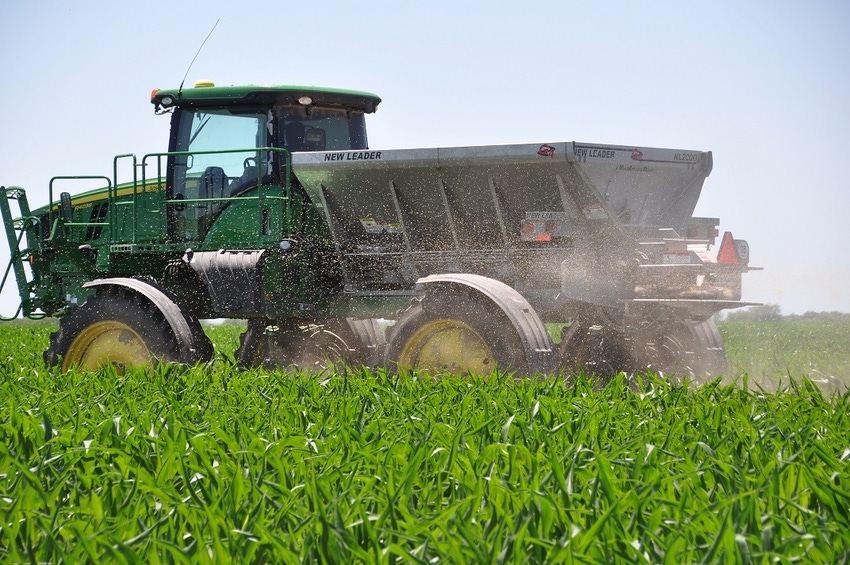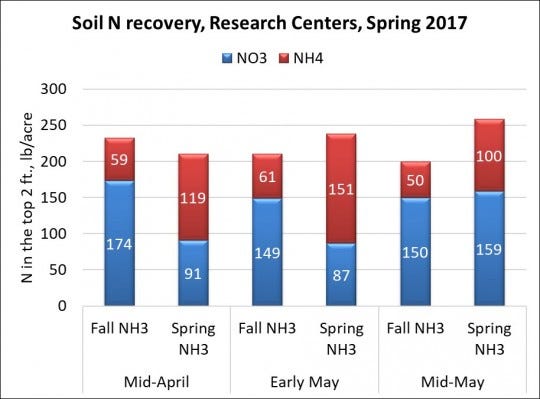
The welcome return to Illinois of drier and warmer weather has allowed most of the remaining crops to be planted, and has brought a lot of improvement to the corn crop that struggled through cool, wet weather during the first and third weeks of May. The plants in many fields have gotten back their green color (or have gotten it for the first time) and the early-planted crop is about to enter the period of rapid growth.
At Willard Airport near Champaign, 316 growing degree days accumulated in April, and 422 GDD accumulated in May. Corn planted in mid-April has by now accumulated about 600 GDD, enough to bring it to growth stage V6 or so. Our corn planted at South Farms on April 20 is a stage or two behind that, probably due to its having experienced cool weather with limited sunshine and wet soils.
I reported here two weeks ago (May 18) on what we’re finding in as we track soil N by sampling this spring. We’re sampling trials at four research center sites where we applied 200 lb. of N as NH3 in mid-November last fall or in early to mid-April this spring.
Planting was delayed by wet weather at the DeKalb site. Samples taken at planting (May 17) showed 266 and 283 lb. N per acre in the top 2 feet for fall-applied and spring-applied N, respectively. These values are only 10 to 20 lb. less than we found on April 24, even though more than 5 inches of rain fell between these two dates. The plots with no N fertilizer had 133 and 135 lb. N at the earlier and later sampling dates; these are on the high side of normal for the soil there. Soil N levels as high as those at DeKalb give us no cause for concern about N loss at this point in time.
At the Monmouth, Urbana, and Perry (Pike County) sites, samples were taken after spring N application in mid-April, in early May after planting, and again in mid-May. On average, 4.5 inches of rain fell between the mid-April and early May samplings, and 2.1 inches fell between the early May and mid-May sample dates. Soils without N fertilizer averaged 90, 77, and 93 lb. N per acre on these three dates.
As I pointed out in my last article, we expect soil N values to rise in May due to increased mineralization as soils warm. That they dropped by early May probably reflected some movement of N out of the soil, or at least movement to more than 2 feet deep. That they increased between early and mid-May is a positive sign that mineralization is now exceeding N movement down. This means that the soil is now in good shape to help supply N for the crop.
Changes in soil N averaged across the three sites for each sampling time are shown in Figure 1. Here again the news is positive; there was a small (10-lb.) drop in soil N with fall-applied N from early to mid-May, while soils receiving spring-applied N showed a small (20-lb.) increase, reflecting the addition of mineralized N. The soil N amounts, while not quite as high as those found at these sites over the same period in 2016, certainly appear to be adequate to meet the needs of the corn crop this year.

Figure 1. Soil nitrate and ammonium recovered from the top 2 ft. of soil following application of 200 lb. of N as anhydrous ammonia in the fall of 2016 or in April, 2017. Data are averages over trials at Monmouth, Urbana, and Perry, Illinois.
Finding more NH4 in early May compared to mid-April for spring-applied N is mostly a consequence of sampling variability, but most of the spring-applied ammonia has converted to nitrate by now. The drop in soil N following fall N application is likely due to the fact that such a high percentage of this N was nitrate already in April, and so more of it moved down as water moved through the soil. We saw similar differences in nitrate percentages with fall- and spring-applied ammonia in 2016, but never had the loss conditions we saw this year, so there was no penalty to having the N present as nitrate. It may well be that 200 lb. of soil N remaining after fall application will still be enough to supply the crop’s N need this year, but this illustrates the risk of having a lot of nitrate present long before crop uptake starts.
There is no doubt that N has moved out of fields this spring and into streams and rivers. The Illinois Fertilizer & Chemical Association reported this week that nitrate levels in Lake Vermilion and Lake Decatur, while not off the charts, were high enough to require nitrate removal by municipal water providers for a few weeks. Levels in Lake Springfield and in Lake Bloomington are also elevated. Although we saw only a small net change in soil N, we believe that the amount of N produced by mineralization moved out of the soil in our trials, and so it’s not surprising to see that some of it reached surface water after exiting the field in tile water.
A little arithmetic helps put N losses from fields into perspective. Let’s say that a field of nearly level soil receives 5 inches of rainfall, and that 4 inches of water enters the soil. Of this, 1 inch remains in the soil (bringing the soil to field capacity) and 3 inches moves down and eventually exits the field through the tile system. One acre-inch of water is 27,154 gallons, which weighs about 226,600 pounds. So 1 part per million (ppm) of nitrate-N is 0.2266 lb. of N in one acre-inch.
If the 3 inches of water that exits our field has 12 ppm of nitrate-N, 0.2266 x 12 x 3 = 8.16 lb. of N per acre leaves the field. Tile line monitoring shows that N movement out of tiled fields is often in the range of 20 to 30 lb. of N per acre per year, typically carried by 8 to 10 inches of water leaving the field through the tiles. We tile fields to improve their productivity, but how much water moves out of a tiled field during the season depends on how much enters the soil in excess of crop uptake, so mostly on rainfall. While we can’t control the amount of water that moves out, we need to do what we can to minimize how much N this water carries with it.
One good way to minimize N loss through tiles is to avoid applying more N than the crop needs to reach its yield potential. Even with the unusually wet weeks this spring that often came after much or all of the fertilizer N had been applied to fields, the fact that we are finding good amounts of N in the soil now should give us confidence that we don’t need to increase N rates this year.
If the crop continues to green up nicely over the next week, that’s because its root system is enlarging out into the soil, and that the roots are finding N as they go. It helps that uptake remains slow – the crop has so far taken up no more than 10 lb. N per acre or so, and its uptake rate hasn’t yet hit 1 lb. per acre per day in most fields. Once the crop reaches stage V8-V9 in mid-June, uptake rates will reach 3 to 4 lb. per acre per day, if not higher. By then, mineralization will be in full swing, and that, along with the N from fertilizer, should be able to meet the crop’s need.
In an N timing study in 2016, we tracked leaf color with a SPAD meter as the color declined before we applied N and as it recovered after we applied N. We found that if we applied 100 lb. of N at planting, both leaf color and full yield potential recovered after we applied the rest of the N, even if that was as late as tasseling or even later. That means we have time to watch the crop for signs of deficiency and to apply more N only if and when such deficiency develops. There’s reason to believe that such deficiency won’t develop as the soil and crop conditions return to normal.
About the Author(s)
You May Also Like




